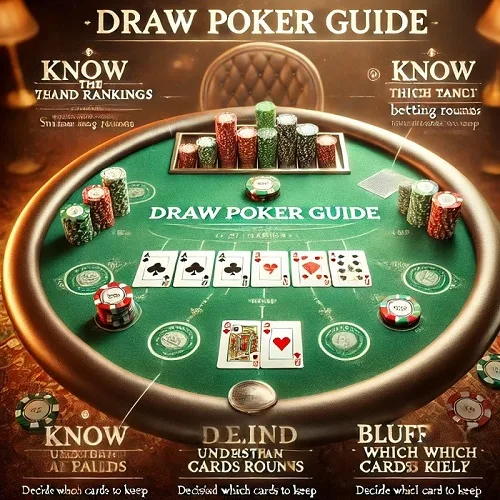
Mastering Draw Poker: Your Ultimate Guide to Winning Strategies
Draw poker is one of the most classic forms of poker, enjoyed by players worldwide for its simplicity and strategic depth. Whether you’re new to the game or looking to refine your skills, understanding the basics and strategies can greatly enhance your experience. This guide will provide you with a comprehensive overview of draw poker, including its history, rules, and tips for beginners.
What is Draw Poker and When Did It Appear?
Draw poker has a long and storied history, tracing its roots back to the early 19th century. The game gained popularity in the United States, particularly during the Wild West era, becoming a staple in saloons and poker rooms. The term “draw” refers to the ability to discard and replace cards in an attempt to improve one’s hand, adding a unique strategic element to the game.
Unlike many other poker variants, draw poker allows players to exchange cards, making it a game of skill and luck. Its simplicity and engaging gameplay have made it a timeless favourite among poker enthusiasts. Over the years, draw poker has evolved, with variations like Five-Card Draw becoming particularly popular.
How to Play Draw Poker: Basic Rules and Tips
Draw poker typically involves two to six players and uses a standard 52-card deck. The game begins with each player receiving five cards face down. A round of betting ensues, after which players can choose to discard and draw new cards from the deck to replace their original ones. This process, known as “drawing,” is followed by another round of betting.
Winning in draw poker requires a combination of skill and luck. Players need to assess the strength of their hand and make strategic decisions on whether to keep their cards or exchange them. One key tip for beginners is to pay attention to the cards discarded by other players, as this can provide valuable insights into their potential hands.
Advice for Beginners
For those new to draw poker, it’s crucial to start with a solid understanding of hand rankings. Familiarize yourself with the hierarchy of poker hands, from high card to royal flush, as this knowledge is fundamental to making informed decisions during the game.
Additionally, patience is a vital trait in draw poker. Unlike some fast-paced poker variants, draw poker requires a more measured approach. Avoid the temptation to draw too many cards at once, as this can reveal the weakness of your hand to opponents.
Another important tip is to manage your bankroll wisely. Setting a budget for your poker sessions can prevent excessive losses and help you enjoy the game more responsibly. Remember, poker is as much about enjoying the experience as it is about winning.
Understanding Betting Strategies
Effective betting strategies are key to success in draw poker. One common approach is the “bluff,” where a player bets aggressively to suggest they have a stronger hand than they do. This can force opponents to fold, allowing the bluffer to win the pot without revealing their hand. However, bluffing should be used sparingly, especially by beginners, as it requires a good read on the other players.
Another strategy involves “value betting,” where players bet when they believe they have a strong hand and want to maximize their potential winnings. Recognizing when to bet, raise, or fold based on your hand and the behavior of your opponents is a skill that develops with practice and experience.
Learning to interpret the betting patterns of other players can also provide a significant advantage. Pay attention to how often your opponents bet, raise, or fold, as these actions can offer clues about their playing style and the strength of their hands.

Variations of Draw Poker
There are several variations of draw poker, each with its own set of rules and nuances. The most popular is Five-Card Draw, where players receive five cards and can draw up to three new cards. Another variant is Triple Draw Lowball, which is played with a low hand ranking system, meaning the lowest hand wins.
In addition to these, there are other less common variations like Badugi, a four-card draw game where players aim to have the lowest hand with one card of each suit and no pairs. Each variation offers a unique twist on the classic draw poker formula, providing new challenges and strategies to master.
Exploring different variations can be a great way to expand your poker skills and discover which version suits your playing style best. Whether you prefer the straightforward nature of Five-Card Draw or the complexity of Lowball games, there’s a draw poker variant for everyone.
Mastering the Art of Draw Poker
Draw poker is a game that combines elements of chance and strategy, offering a rewarding experience for players of all skill levels. By understanding the rules, mastering basic strategies, and practicing patience, you can improve your game and enjoy the thrill of this classic poker variant.
As with any form of poker, the key to success in draw poker lies in continuous learning and adaptation. The more you play and study the game, the better you will become at reading your opponents and making strategic decisions. So, whether you’re a casual player or aspiring to play professionally, draw poker offers endless opportunities for growth and enjoyment.
Remember to play responsibly and, most importantly, have fun. After all, poker is not just about winning; it’s about the experience and the joy of the game.
